

Brush with garage greatness
I got an email from reader Derek Staples that, based on years of correspondence with the readers of this column, may well ring true with many of you. For many race fans of – ahem – advanced seniority, introduction to the sport sometimes came from a neighbor who housed his race car in the garage, its front end provocatively peeking out at you as you rode your Schwinn up and down the street until your curiosity overcame the intimidation factor and you stuck your nose in the doors and uttered a hopeful, “Hey guys …” Or maybe you lived close to a cluster of shops, where you and your buddies would buzz by, hoping for a “Hey kid!” invitation. Or maybe you were blessed to have a rich uncle with a hot rod. However it happened, you fell in love.
For some, that hesitant introduction led to offers to polish the wheels or sweep the shop or – gasp – maybe an invitation to wipe tires at the drags. Before long, maybe you were on the road, working your way up the food chain. You went from fetching hot dogs to bolting on the wheels and maybe even getting to work the bottom end. For some, it was a summer in heaven, for others, the beginning of a lifetime commitment when you first -- as our late, great Photo Editor Leslie Lovett used to say -- “ran away with the circus.”
Even if you weren’t lucky enough to breach the inner sanctum of the shop, you still were overwhelmed by the beauty of the racing machine. Maybe you’d seen some in magazines, but once you saw its gleaming naughty bits up close, you were hooked. Sound familiar?
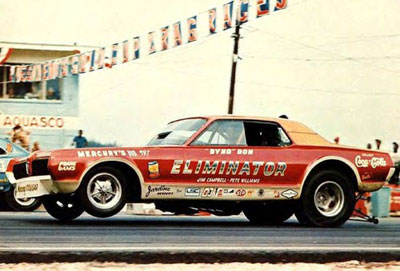 |
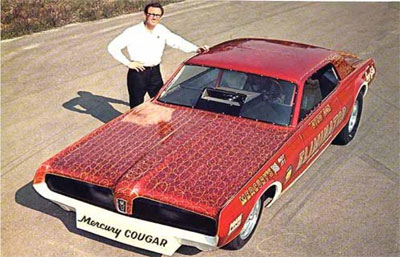 |
Anyway, back to Staples (hey, that was easy!) and his letter.
“When I was a kid, back in '70, I remember ‘Dyno Don's’ [Nicholson] Eliminator Cougar Funny Car sitting in my cousin’s garage in Lilburn, Ga. Needless to say, that helped start a lifelong love affair with drag racing. What I'm wondering is how this particular car wound up where it did. I know ‘Dyno Don’ had an Atlanta connection, but that's about all I know. Any help at all would be appreciated.”
I turned to National DRAGSTER’s Nicholson expert, John Jodauga, who actually toured a bit with Nicholson (J.J. wrote about his experiences with Nicholson and with Bill “Grumpy” Jenkins in his Speaking of Speed column in this week’s issue), to get the answer to the question.
“Nicholson grew up in Southern California and had worked a chassis dyno at Service Chevrolet in Pasadena, which was the source of his ‘Dyno Don’ nickname,” said Jodauga. “After he won Top Stock at the 1961 Winternationals with his Chevy 409, he received so many requests for match race appearances on the East Coast that he purchased a home in Atlanta. The Cougar was Nicholson’s third Logghe Chassis flip-top Funny Car, with the first two being the Eliminator I and Eliminator II Comets. The Cougar was simply known as Eliminator with no Roman numeral.”
I wondered why the newest Eliminator didn’t bear the III designation (after all, Don Garlits was making a lot of headlines with his sequentially numbered Swamp Rats) until I stumbled across some background information about Mercury Cougars that revealed that Mercury adopted the Eliminator name as a performance package for the Cougars, consisting of a standard 351 or the optional 390, 428CJ, or Boss 302. You also got a racer-like blacked-out grille, side stripes, front and rear spoilers, an optional Ram Air induction system, and a performance-tuned suspension package. I couldn’t find any documentation tying the two together, but because Nicholson (along with Eddie Schartman) was Mercury’s showcase racer, it makes sense that they may have asked him to call the car simply Eliminator. (You can find out more than you ever wanted to know about the Eliminator package here.)
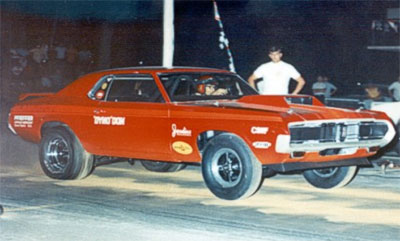
Don Nicholson's short-lived Super Stock match race Cougar.
|
Nicholson didn’t remain in the Funny Cars long, though, according to Jodauga. “Near the end of 1968, Nicholson turned the driving duties of the Cougar over to Frank Oglesby, who did not enjoy the same level of success that Nicholson had in the three previous seasons. Nicholson began racing the former Jerry Harvey ’66 A/FX Mustang in A/MP and won the Street Eliminator title with it at the 1969 Springnationals. He also briefly drove a ’69 Cougar heads-up Super Stock match race car in 1969, but it proved to be too heavy. When Pro Stock was introduced in 1970, he put together a ’70 Maverick with a SOHC 427-cid engine at Sherm Gunn’s M&S shop in Irwindale, Calif., and drove a similar ’71 Maverick to Ford’s first Pro Stock victory at the 1971 Summernationals.”
And we know the rest of the story: consistent national event winner; NHRA Pro Stock world champ in 1977; named to the No. 18 spot on NHRA’s Top 50 Drivers list in 2001; inducted into the International Drag Racing Hall of Fame and the Motorsports Hall of Fame; and passed away in January 2006 at age 78, still a legend among legends.
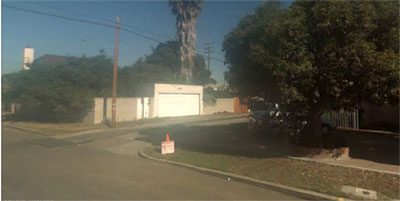 |
I had my own brush with race car greatness at a young age but didn’t really realize it at the time. In fact, it wasn’t until even a few years ago that I learned some background on the car, and I still don’t know everything I should about it. As I’ve shared here before, I grew up in Culver City, Calif., which was quite a hotbed for hot rodding in the early 1960s. I wasn’t old enough to be “in the scene” yet or even knowledgeable about it, but I knew what drag racing was and had just a faint idea of what drag racing cars looked like.
I lived in the first house on our block, separated from the corner-lot house by a dirt alley where I and my buddies played Evel Knievel on our bicycles. The corner house fronted a big street (Culver Boulevard), so the garage was in the rear of the house, accessible via the alley. That’s my childhood house on the right in the Google Street View image above (partially obscured by a tree that I used to climb as a kid; why didn’t my parents think of bricking over the front grass?; would have saved me a lot of lost Saturday afternoons with the mower!). The garage in question (big white door) is just across the now-paved alley, so you can see I had a pretty good view of it.
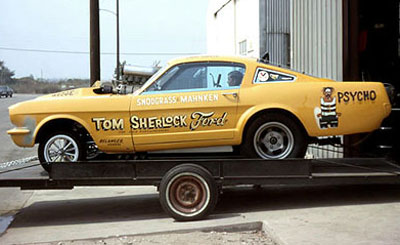 |
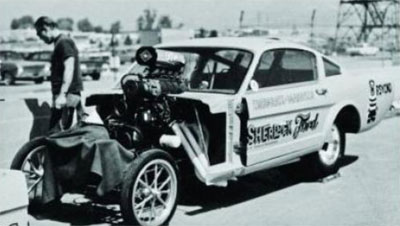 |
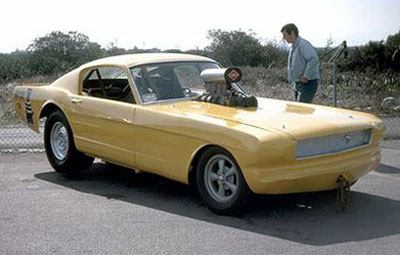
The second Psycho, an ex-Gas Ronda Mustang
|
One day in 1969, the garage door opened, and inside was a Mustang with a big ol’ blower sticking out of the hood and a Screaming Yellow Zonker of a paint job. I knew it was a race car of some flavor but wasn’t sure what to make of it. Funny Cars were still kind of crude, but it didn’t look like a Funny Car. I never saw it leave on a trailer or heard it fire, and, honestly, I don’t remember it even residing there very long. As the years went on and the Mustang faded from memory, all that I could recall about it was the crazy drawing on the rear flank of a guy clearly in the process of losing his mind.
A few years ago, I came across a photo in our files while working through the alphabet on my Misc. Files series (that actually started online but migrated into print in DRAGSTER) that looked vaguely familiar and turned out to be that Mustang of my youth, which turned out to be a hybrid fuel altered/Funny Car named Psycho. DragList, of course, had the full scoop on the car, which was owned by Ralph Snodgrass and Pat Mahnken from Azusa, Calif. – ironically, the next town over from where I now live in Glendora – and driven by Larry Barker from similarly nearby Covina, Calif.
Researcher Danny White had a lot of good information about the car. Snodgrass and Mahnken had raced the chassis (reportedly built by Barker) as an A/Fuel Altered (injected on gas) with 427 SOHC power, a Fiat Topolino shell, and Mahnken in the cockpit but switched to the ’67 Mustang bodywork when they got sponsor dollars from Tom Sherlock Ford in Pasadena, Calif. The car switched to 427 wedge power, and Barker took over the controls and drove the car to victory in Comp at the 1967 Hot Rod Magazine Championships as an AA/FA. A second Mustang – an ex-Gas Ronda piece – replaced the first but was soon retired and later sold to an Australian racer, and Mahnken ended up bracket racing the initial car.
The rub is that I can’t find any reference to Culver City, which is a good 45-minute drive west of both Azusa and Covina. Was the mysterious Aussie my neighbor? I’m not even sure now which of the Mustangs it was. Anyone know?
And, while we’re channeling this whole theme, I’d like to hear from you guys about your earliest hanging out at the local stud racer’s garage and how it led to you getting hooked on the sport. Photos a plus!!
I’ll see you later this week.



















































